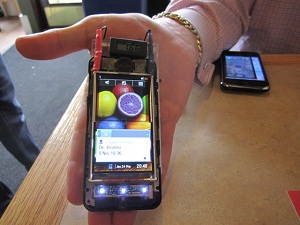Company unveils solar integrated cell phone technology
 Know what I hate about cell phone chargers, they break. But in a few years, they may be obsolete, thanks to new solar technology that created a transparent, flexible photovoltaic cell. Wysips (What You See is Photovoltaic Surface), a subsidiary of French company SunPartner SAS, is now demonstrating this game-changing technology, and said it could introduce it on devices as soon as 2012.
Know what I hate about cell phone chargers, they break. But in a few years, they may be obsolete, thanks to new solar technology that created a transparent, flexible photovoltaic cell. Wysips (What You See is Photovoltaic Surface), a subsidiary of French company SunPartner SAS, is now demonstrating this game-changing technology, and said it could introduce it on devices as soon as 2012.
The panel can fit under the lens of a mobile device, like an iPhone and can power a cell phone, tablet or e-book without interfering with the touch screen or a new 3D glasses free screen. What’s more, the technology is expected to cost about $1 for a 4-inch device—game changed.
I can’t wait to toss the third charger I’ve bought for my antiquated cell phone out the window when I get my hands a device with an integrated, invisible solar panel.
I got my muggy paws on a demonstration unit fresh off the plane from Florida, where it won an Emerging Technology award in the Enterprise & Vertical Market: Green Telecom & Smart Energy Solutions, Apps & Hardware category at the International CTIA Wireless convention. Though the demonstration device is definitely rough (see pictures), it’s easy to see the potential.
“We believe the is the first fully-transparent photovoltaic film. It works because it has a lenticular lens on one side, then the amorphous PV on the backside, and what essentially happens is the lenses focus the light on the PV. The lines are pretty thin—about one micron,” said Robert Witkow, president of Westwood Marketing, LLC, which partnered with Wysips to bring the device to market.
The devices Witkow showed me were a Samsung phone powered by the device, and an iPhone with the device placed under the touch screen, which allowed the screen to work.
The Samsung phone had its shell off and was mounted on a clear piece of plexiglass so you could see the connections. It also included a voltmeter showing how much the power the device was producing. Even in the dimly-lit coffee shop the device was still producing electricity. When we walked outside, the amount of energy generated spiked.
“The production version we believe will produce 500 milliwatt hours that charges a full battery charge in six hours,” Witkow said. “It’s well on its way to making this phone self-sufficient. We think in a few generations literally the time out-of-pocket, indoors or outdoors, will be enough to support the phone.
“Right now what we believe is the phone manufacturers are going to be able to install this and cut the battery substantially, cut the cost of the battery and still extend the life of the phone.”
In the demo unit, there was some shading from the panel. Witkow attributed the shading to tape used to keep the device in place and not aligning the PV with the pixels.
“In the production versions, when its inserted in the factory—no tape. This should be pretty doggone clear,” he said. Further, when solar cell is aligned with the pixels in a device, you won’t be able to see it.
Wysips isn’t the only company to propose or even patent such a device. For instance, Apple has filed four patents and secured one for integrating solar into chargers into displays of its devices. Wysips looks well-positioned to be the first to bring the technology to market.
At this point, the company hasn’t signed any contracts that it can announce, Witkow said. But the company may announce its first contracts in the next 60 days.
“With regard to Wysips, [we say] don’t let your imagination be an obstacle to success. There’s just nowhere that this thin-film can’t be applied,” he said. “It’s energy within an image.”



